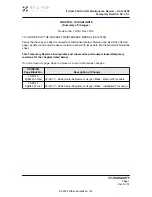
20
FLYING THE CHRONOS
of the canopy backwards is corrected by easing up on the brakes to let the canopy
move forward.
When you have become fully confident in your wing try experimenting with slower and
faster trim-settings, weight-shift and speed bar. The more time you spend on your
Chronos the more likely you will enjoy the extra speed and security it will offer you.
Different trimmer settings
NOTE: Adjusting trimmers in flight requires more pilot attention.
With the trimmers fully open (trimmer buckle over and passed the white line) the wing’s
speed increases (good for flying long distances). The canopy becomes stiffer and is less
sensitive to turbulence and its stability improves. On faster trimmer settings or when
flying with a speed bar the brake pressure increases and the handling changes. When
the trimmers are fully opened and the speed bar is pushed all the way forward, we
recommend steering the glider using the torque compensator lines.
Some pilots with free-flying experience may have a tendency to keep the brakes slightly
applied at all times. Such a technique, while quite reasonable on a free-flying wing, is
not advisable for semi-reflex gliders. When you apply the brakes with released trimmers
and full speed bar the wing will collapse because it loses its semi-reflex characteristic.
Warning!!! On faster trim settings with fully accelerated speed bar do not touch
the brakes! Doing so will result in major collapse!
Warning!!! In according to its construction some manoeuvres could not be tested. It is
asymetric and frontal collapses in the combination of accelerator and open trimmers.
On the slower settings (trimmer buckle pulled below the white line), sink rate improves
and handling becomes lighter, giving you an improved climb rate for thermaling and
shorter and slower take-offs and landings. Do not hesitate to use thermals in order to
gain some altitude and save fuel.
Note!! If trims are not adjusted the same, the wing will turn. Trimmer setting is an
important part of the checklist before every flight!
Accelerated flight (speed bar applied)
When flying with the speed system engaged the angle of attack is lower and the glider
increases flight speed. In contrast to most paragliders it does not decrease wing
stability; in fact the semi-reflex gliders seem to counter turbulence even better.
To use the speed system and accelerate the glider, simply place your feet on the stirrup
and push forward in a horizontal plane. If you feel a loss of back pressure while flying
with the speed bar engaged, this is a warning that the canopy is probably about to
collapse. Release the speed system immediately by releasing the pressure on the
speed bar. Do not use the speed system in very turbulent conditions, close to the
ground or near other airspace users. Always fly with sufficient clearance from the
ground/obstacles and always keep the brake handles in your hands!
Summary of Contents for Chronos
Page 1: ...1 ...
Page 10: ...10 TRIMMING ...
Page 35: ...35 LINE PLAN CHRONOS SCHEME ...
Page 40: ...40 ...













































